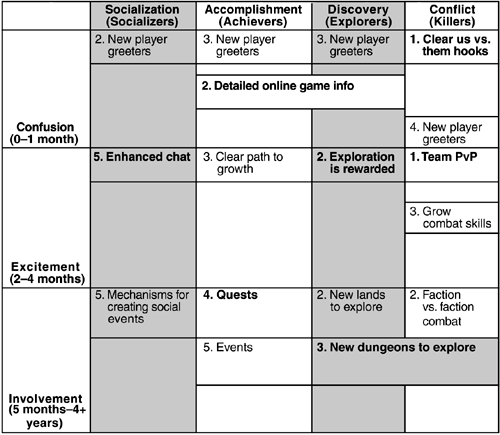The Themis Group Player Satisfaction Matrix
| "As we talked with various developers and publishers," says Alex Macris, CEO of The Themis Group, [5] an online game consulting and full-service support company, "we began to notice a trend: The teams had no firm grasp of who the potential customers were or how their feature set appealed to those customers. They just assumed that everyone played for the same reasons and wanted every possible feature. Trying to make the teams understand the differences between the general player types and what they wanted in a game was frustrating at times."
To get a handle on this problem, Macris devised an unusual and innovative solution. What he realized is that, although many people in the industry knew what the separate features were, no one had taken the time to plot them out in a logical, easy-to-see manner. He also knew that development teams understand issues and concepts best when arranged as data points in a matrix; trying to just explain features to them as concepts made things more difficult, not less. So he sat down and drew out a basic matrix chart that correlated the Bartle player types against the game features they needed or wanted at various stages in their lifecycle for an online game. The format Bartle arrived at was one of those simple solutions that the industry has needed but somehow missed for years . Table 8.2 shows how Macris expressed the player lifecycle and satisfaction factors in a simple matrix. Table 8.2. Basic Player Satisfaction MatrixThe Player Satisfaction Matrix is copyright Themis Group 2001 “2002 and used with permission. Down the left side of the matrix are the first three periods of the average player lifecycle, as noted in Chapter 1. Across the top run the major activity types that parallel the four Bartle types: socializers , achievers , explorers, and killers. The boxes that cross- reference each lifecycle period with a player type list the features those players want or need at that stage of their "career" in the game. What The Themis Group does for a game is first fill in all the relevant features for the "complete" PW, with the features prioritized from highest to lowest needed, as shown in Table 8.3. Table 8.3. The Player Satisfaction Matrix, First Step Examining Table 8.3, you'll see at the left are the first three phases of the player lifecycle. At the top are the four main PW player types according to the Bartle index. In each box are the general features each player type needs or wants at each phase of the lifecycle. Within this matrix, any experienced design team member at Themis can go through the filled-in features boxes and highlight the features that exist in the game, as denoted by the bolded features in Table 8.4. Table 8.4. The Player Satisfaction Matrix, Partially Filled When the work is finished, the team has an invaluable tool; it can tell at a glance which features are currently planned or existing in the game and which features are missing for specific player types. This method has proven to be of enormous help in focusing design and development on just what should be in a game at launch to help acquire subscribers and which features are needed to retain subscribers long term but can be added at a later date, say, through an expansion pack or server-side patch. The trick is to know what feature set is needed for your game to function competitively at a base level in the marketplace and build from there. Table 8.5 is a partial list of features we believe necessary for the acquisition and retention of subscribers at all levels, from hard- core gamers to mass-market non-players. Bear in mind that while many acquisition features are also retention features, a retention feature does not always work for acquisition. Table 8.5. Basic Acquisition and Retention Features |
EAN: 2147483647
Pages: 230
- Challenging the Unpredictable: Changeable Order Management Systems
- The Second Wave ERP Market: An Australian Viewpoint
- Healthcare Information: From Administrative to Practice Databases
- A Hybrid Clustering Technique to Improve Patient Data Quality
- Relevance and Micro-Relevance for the Professional as Determinants of IT-Diffusion and IT-Use in Healthcare



